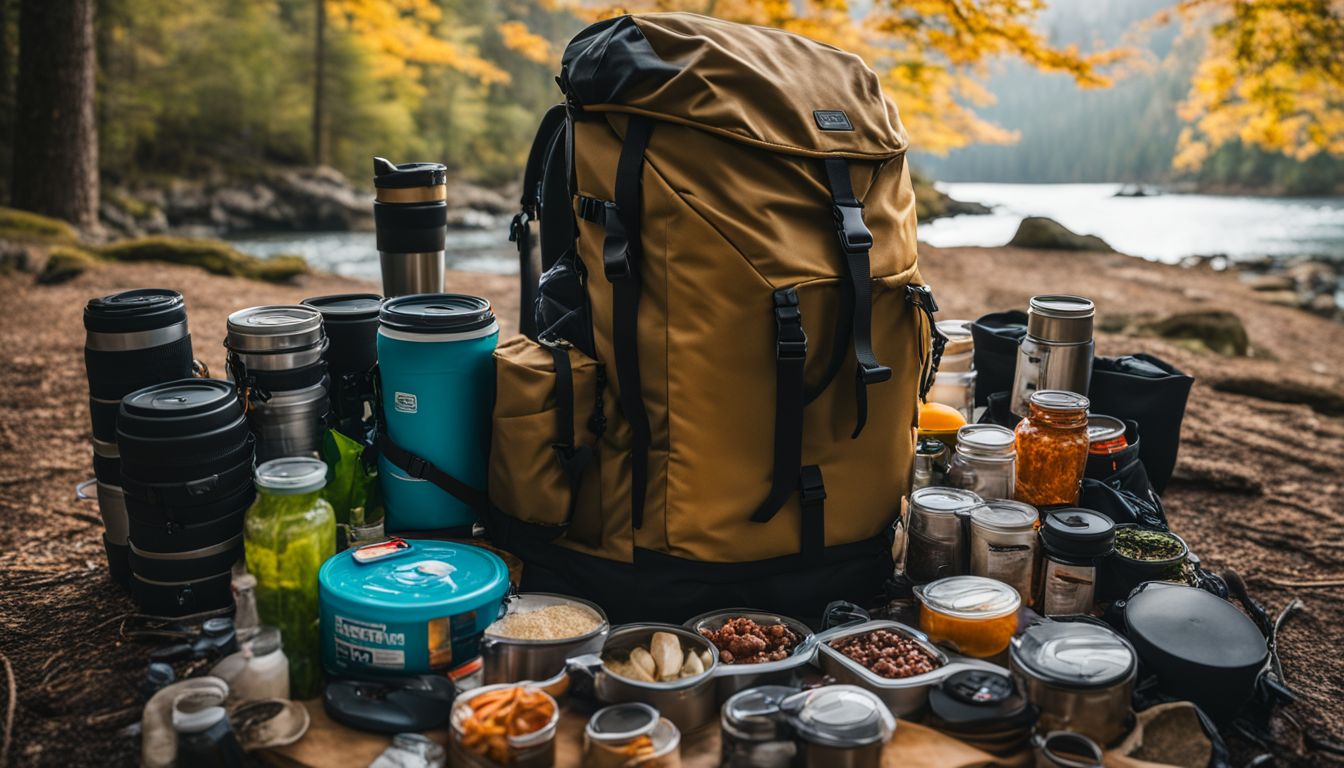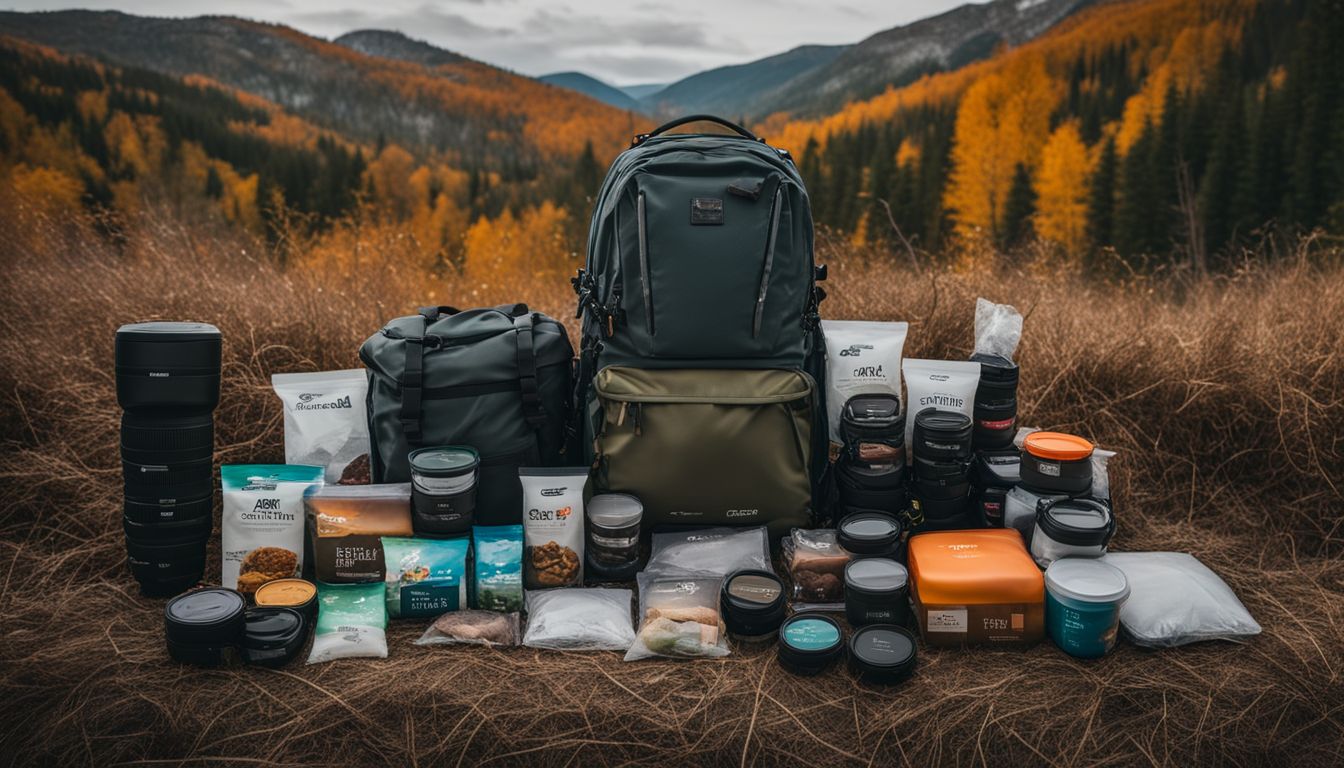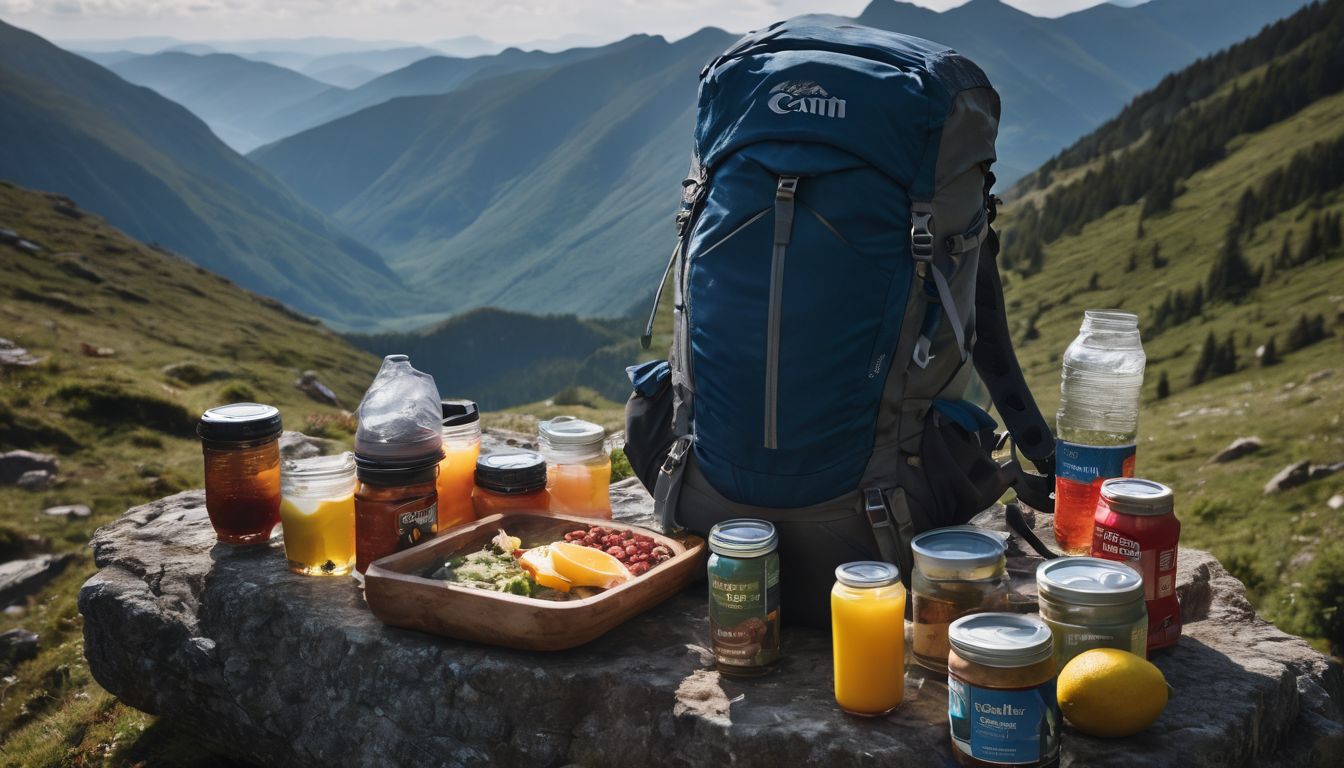Embarking on a backpacking adventure requires more than just a love for the great outdoors; it demands strategic planning, especially when packing food and drinks in your rucksack.
Many enthusiasts face the puzzle of balancing nourishment against the weight they have to carry – an equation that can make or break their journey. Leveraging years of trekking through diverse terrains, I’ve honed my expertise on what works best when every ounce matters.
Crafting the perfect food cache isn’t about stuffing your pack with supermarket finds; it’s about selecting calorie-dense sustenance that fuels prolonged activity without unnecessary bulk.
This article unpacks the art of efficient meal preparation and offers innovative packing hacks, ensuring you’re energized from breakfast to dinner without lugging extra pounds. Stay tuned as we dive deep into these game-changing tips—you won’t want to miss out!
Key Takeaways
- Select calorie – dense foods like energy bars, nuts, and dried fruits to fuel your trek while minimizing weight.
- Utilize efficient packaging techniques such as vacuum sealing meals and repackaging bulky items into smaller containers to optimize space and keep food fresh.
- Prioritize proper hydration by employing reliable water treatment methods and utilizing durable containers for safe drinking water storage during the trek.
Essentials of Rucksack Food Packing

When preparing food for your rucksack, it’s important to select the right foods that provide energy and nutrition while balancing weight and caloric density. Organizing and packaging your backpacking meals efficiently is crucial in ensuring you have enough sustenance for your trip without adding unnecessary weight to your pack.
Selecting the Right Foods for Energy and Nutrition
Picking good foods for your hike is a big deal. You need snacks that give you power and keep you healthy. Think about energy bars, nuts, nut butters, and trail mix. These are great while walking because they’re packed with energy.
Dried fruits like bananas or fruit cake can also help keep your legs moving on the trail.
If you’re bringing perishable goods like sandwiches, use an ice pack to keep them cool. Add chicken or fish in foil pouches for extra protein. They don’t weigh much and make meals tastier.
Look for foods that have lots of calories in just a small amount – at least 100 calories per ounce is good.
Your drink choice matters too! Breakfast drink mixes or instant green tea can refresh you without adding weight to your backpack. Always check the nutrition label before buying groceries for your trekking adventure; it tells you if what’s inside will fuel your journey right.
Balancing Weight and Caloric Density
It’s smart to pack foods high in calories but low in weight. This means choosing eats that give plenty of energy without making your backpack heavy. Fats are great for this because they have more calories in each gram than carbs or proteins do.
Think about mixing nuts, seeds, and nut butters with dehydrated vegetables and grains like instant rice. It’s a good plan to have both quick energy snacks like granola bars and longer-lasting fuel from things like salami or dry fruits.
Carry meals that are simple to make and use little fuel from your camping stove. Prepackaged meals can be light and easy if you take them out of their boxes and put them into ziploc bags before you leave home.
This helps keep your load lighter so you can enjoy the trek without extra weight slowing you down.
Organizing Your Backpacking Meals

When it comes to organizing your backpacking meals, having a meal prep strategy and efficient packaging tips can make all the difference. With limited space in your rucksack, it’s essential to prioritize compact and lightweight options that will provide you with the necessary energy for your trek.
Meal Prep Strategies
Meal prep is key for backpackers looking to save space and keep their food fresh. Start by choosing meals that are simple to make and high in energy. Think about what you will eat each day on the trail, including snacks, lunches, and dinner.
Pack foods that won’t spoil quickly and consider using a vacuum sealer to remove air from bags of food. This not only keeps your meals safe but also makes them take up less room in your backpack.
For every meal, write down what you need and check if it can be bought at grocery stores before you leave or needs special preparation at home. Repackaging bulky items into smaller zipper bags saves space and makes it easier to find what you need when it’s time to cook.
Plan your meals so the ones you’ll eat first are on top; this helps with both food safety and organization.
Now let’s focus on keeping those carefully prepped meals safe in “Packaging Tips for Space Efficiency.”
Packaging Tips for Space Efficiency
When it comes to backpacking, efficient packing is key to optimizing space and weight. Utilize these packaging tips to make the most of your rucksack:
- Repackage Ingredients: Transfer store-bought items like rice, pasta, and snacks into zipper bags or small containers to minimize bulky packaging.
- Vacuum Seal Meals: Use a vacuum sealer to condense meals into compact, airtight packages that save space and keep food fresh.
- Utilize Packing Cubes: Organize smaller food items in packing cubes to prevent them from shifting and taking up unnecessary room in your backpack.
- Layer Items Efficiently: Place flat items like energy bars or wraps between layers of clothing or gear to optimize every inch of space in your pack.
- Compact Cookware: Invest in collapsible pots and utensils that can be nested together, saving valuable space while still providing essential cooking tools for your trip.
- Opt for Lightweight Packaging: Choose lightweight containers or packaging for foods such as dehydrated meals or energy gels to minimize overall weight without sacrificing nutrition.
- Plan Multi-Use Items: Select foods that can serve multiple purposes, such as oatmeal that doubles as breakfast and a baking ingredient for campfire treats.
Food Packing Techniques
Utilizing internal packing zones allows for efficient organization and easy access to food while on the trail. Waterproofing and protecting your food is essential to avoid spoilage or damage during your outdoor adventures.
Utilizing Internal Packing Zones
When organizing your backpacking meals, utilizing internal packing zones is crucial to protect and preserve foods from hazards. Here are some tips for effectively utilizing internal packing zones:
- Place heavy items closer to your back for better weight distribution.
- Keep frequently used items easily accessible in the top or side pockets.
- Use compression sacks or packing cubes to separate different food categories and prevent shifting during the trek.
- Opt for resealable bags or containers to keep smaller food items organized within the packing zones.
- Utilize waterproof dry bags or liners to create a dedicated zone for liquids and prevent leaks.
Waterproofing and Protecting Your Food
When trekking and packing food in your rucksack, it’s crucial to ensure that your food stays safe from water and physical damage. Here are some techniques to help you waterproof and protect your food:
- Utilize odor – proof and waterproof plastic bags to store individual food items securely, preventing any unwanted odors from spreading and protecting them from moisture or rain.
- Employ tough plastic garbage bags to line the inside of your backpack, creating an additional layer of protection against water seeping through.
- Consider using resealable vacuum-sealed bags for high-value items, such as emergency rations or fragile snacks, to guard against moisture and physical damage.
- Place delicate items in the center of your backpack surrounded by softer items to act as a cushion against potential impact during the journey.
- Pack food in durable containers, such as hard plastic or metal, to prevent crushing and maintain the integrity of the packaging.
Hydration on the Trail
Ensure that you have effective water treatment and storage methods in place to stay hydrated during your trek. Proper hydration is crucial for endurance and performance on the trail, so it’s essential to prioritize this aspect of your packing.
Effective Water Treatment and Storage
Water is vital for hikers, so it’s crucial to manage this resource wisely during your trek. When it comes to hydration on the trail, contamination is a real concern. Ensure you’re equipped with reliable water treatment methods such as filtration systems, purification tablets, or natural purification techniques like boiling or using ultraviolet light.
These methods help in making untreated or poorly treated water safe for drinking. Also, remember that treating water effectively reduces the risk of getting sick from harmful bacteria and viruses commonly found in natural water sources.
Proper storage of treated water is equally important. Utilize durable containers that are designed for storing drinking water safely while hiking. By packaging your clean water appropriately, you can prevent contamination and ensure a safe supply throughout your journey.
Additional Packing Considerations
When packing your rucksack, don’t forget to consider the best ways to organize and pack your clothing for optimal space efficiency and easy access on the trail. Read on to learn more about how to maximize your backpacking experience!
Clothing Packing Techniques for Rucksacks
When packing clothing in a rucksack, it’s essential to optimize space and minimize wrinkles. Here are some techniques for efficient clothing packing:
- Utilize packing cubes to compartmentalize and compress clothing items, maximizing the use of available space within the rucksack.
- Employ rolling and folding methods to minimize wrinkles and make efficient use of space, ensuring that clothing remains organized and easily accessible during your trek.
- Pack versatile and lightweight clothing items that can serve multiple purposes, reducing the overall volume of clothing without compromising on functionality.
- Consider the climate and duration of your trek when selecting clothing, prioritizing moisture-wicking fabrics and layering options for varying weather conditions.
- Prioritize essential items such as socks, underwear, and base layers at the bottom of the rucksack for easy access while maintaining stability within the pack.
- Opt for quick – drying fabrics to facilitate easy washing and drying of clothing during extended treks, allowing for minimal downtime between wearings.
- Utilize compression bags or waterproof stuff sacks to protect clothing from moisture and optimize space within the rucksack, particularly for longer expeditions or challenging weather conditions.
Conclusion
In conclusion, packing food and drink in a rucksack for backpacking requires careful planning and organization. The tips provided here emphasize practicality and efficiency, ensuring that your meals are easy to pack and provide the necessary energy.
By selecting the right foods, balancing weight and caloric density, and organizing your backpacking meals, you can significantly improve your outdoor experience. Proper hydration techniques and additional considerations such as clothing packing techniques further enhance the impact of these strategies.
Remember, with thoughtful preparation, your backpacking trips can be more enjoyable and fulfilling experiences.
For more tips on preparing for your adventure, check out our guide on clothing packing techniques for rucksacks.
FAQs
1. How do I pack food for a hike in my rucksack?
You can repackaging food into smaller bags or vacuum sealing them to save space in your backpacks. Choose light and easy-to-carry items from supermarkets or health food stores.
2. What is the best way to keep my drinks safe in a backpack?
Use bottles that seal tight and store them upright if possible. Also, you might put your drinks in a separate pocket away from foods to avoid spills.
3. Can I bring cooking tools in my rucksack for making meals?
Yes, you can take small cooksets, like a little cooking pot, but make sure they are lightweight especially if you’re on a long thru-hike.
4. Should I use special containers for packing food?
Special containers like hard-sided boxes protect packaged foods well and help prevent animals from smelling your food while camping overnight with sleeping bags.
5. What kind of sleeping bag works when carrying food and drink in my pack?
Choose a compact sleeping bag that leaves plenty of room for food storage so everything fits inside your rucksack without causing blisters or too much weight on your back.

